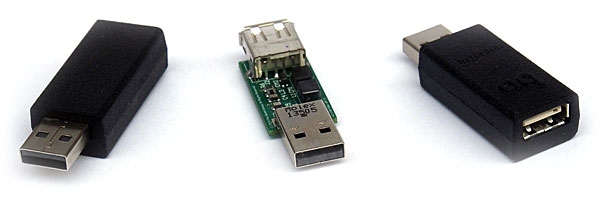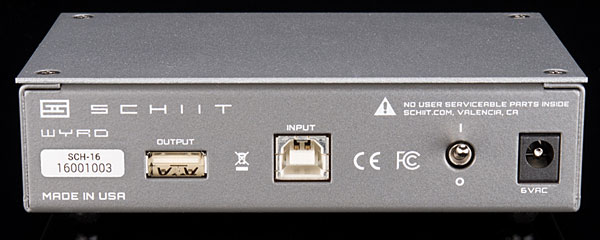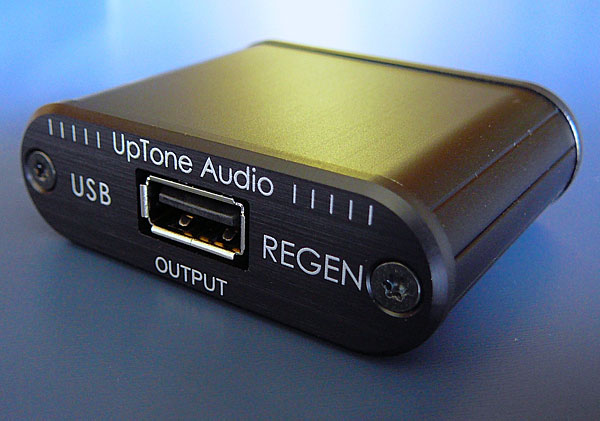| Columns Retired Columns & Blogs |
Wonder why Firewire was abandoned if it was faster at transferring bits than USB and not having to contend with his noise issue

We also need to keep in mind that a USB cable is responsible for transmitting not only your data, but also the 5V DC power leg supplied by the computer and used by most DACs. Some DAC designers disregard this USB-based power, preferring to generate their own, cleaner power, in order to prevent noise from corrupting the analog signal in the DAC. Just in case your woo detector is flashing, remember: Many DACs also employ galvanic isolation to keep unwanted, incoming USB-based noise from getting past the USB receiver.
AudioQuest JitterBug ($49)
AudioQuest's full name for this is the JitterBug USB Power & Noise Filter, which tells us a bit more about what it does. (For a thorough description, read John Atkinson's review in the September 2015 issue.) In brief, the JitterBug is a small, passive device the size of a USB flash drive, with a USB Type-A female input at one end and a USB Type-A male plug at the other. AudioQuest claims that when you insert the JitterBug between your USB cable and computer, it "measurably reduces unwanted noise currents and parasitic resonances. It also reduces jitter and packet errors (in some cases, packet errors are completely eliminated)."

AudioQuest also recommends plugging an additional JitterBug into an unused USB port on the computer serving your music, and plugging extra 'Bugs into unused ports on any other device—router, NAS, etc.—on the same network as that computer. (But the company advises plugging no more than two JitterBugs into any single device.) Plugging unused USB ports is said to serve two purposes: It keeps radiated electromagnetic and radio-frequency interference (EMI and RFI) from getting into open ports, and it keeps any noise generated by the USB bus itself from polluting the device.
Schiit Audio Wyrd ($99)
Schiit Audio claims that their Wyrd USB Power Isolator "isolates your USB DAC from the noisy USB power coming from your computer and provides a stable, precise [crystal] oscillator to repeat the USB 2.0 packets"—the latter being another way to say that the Schiit Audio Wyrd reclocks the incoming datastream. Why bother doing that? The answer has to do with a bit of hardware called the PHY (for physical layer, which is one of many elements within a data-transfer system): UpTone Audio (see below) tells us that DACs prefer a clean signal, since the more work that's assigned to the USB PHY that resides in every computer-audio DAC, the more noise it generates. And that noise can find its way into your DAC's analog circuitry.

Because the Wyrd (pronounced weird) is to be inserted between your computer and DAC, you'll need two USB links: one from your computer to the Wyrd's USB Type-B input, and one from the Wyrd's USB Type-A output to your DAC. The Wyrd's metal case, which measures 5" wide by 1.25" high by 3.5" deep, also houses a linear power supply, a rear-mounted On/Off toggle switch, and two front-mounted white LEDs that indicate power and connection status. Like every Schiit product I've had and held, the Wyrd is solidly built, and its lack of plastic is especially welcome at the price.
UpTone Audio USB Regen ($175)
UpTone Audio's USB Regen, like Schiit's Wyrd, is a powered, single-port USB 2.0 hub that takes the USB signal from your computer, regenerates (ie, reclocks) the data, provides cleaned-up 5V power from a built-in, ultra–low-noise regulator, and sends an impedance-matched signal to your DAC. The Regen is designed to sit as close to your DAC as possible; UpTone supplies a male/male USB A/B adapter—a solid, double-ended plug, which they recommend over the 6"-long male/male USB A/B cable they also provide.
At one end of the Regen's small (2.2" wide by 0.7" high by 1.8" deep) case of black-anodized aluminum is a USB Type-B port for connecting the USB cable from your computer, and a 5.5 by 2.1mm barrel jack for the included supply. At the output end is a USB Type-A port for use with the adapter plug mentioned above. An amber-colored LED indicates the power status.

UpTone talks about four main issues the Regen is designed to address: PHY noise, signal integrity, packet noise, and "frequency optimizing" of the power-delivery network. Again, each of these pertains to noise inside the DAC that could pollute the analog signal.
It's interesting to note that each of these devices is designed to occupy a different place in your system: The JitterBug sits at the source, the Wyrd goes in between source and DAC, and the Regen cozies right up next to your DAC.
Re-make/Re-model
I began my listening sessions by adding to my system four AudioQuest JitterBugs. I plugged one into my MacBook Pro (and used a Light Harmonic Lightspeed USB cable to connect the 'Bug to my reference Auralic Vega DAC); another JitterBug in the MacBook's unused USB port, via a short USB cable (two 'Bugs can't fit into side-by-side ports); a third into an unused USB port on the NAS that stores my music library; and a fourth into my router. The rest of the system comprised a Pass Labs INT-30A integrated amplifier and DeVore Fidelity The Nines speakers.
I left the JitterBugs in my system for a few weeks and simply enjoyed listening to all manner of music, as any normal person would. Then I removed all four 'Bugs and sat back down in my red Eames LCW chair to listen to 44.1kHz files from Jordi Savall and Hespèrion XXI's Altre Follie, 1500–1750 (Alia Vox 9844), a lovely album of Renaissance music.
While I still enjoyed myself, as any normal person would, I noticed a number of changes to the sound of Altre Follie. Most notable was a loss of clarity. The dozen or so musicians of Hespèrion XXI weren't as distinctly separated-out in space as they were with the JitterBugs, and the overall space of the recording now seemed condensed and somewhat cluttered in comparison. These differences were at once easy to hear yet subtle: I wasn't experiencing the same degree of change I hear when I add, say, a new DAC.

Wonder why Firewire was abandoned if it was faster at transferring bits than USB and not having to contend with his noise issue.
As I understand it, FireWire is more expensive to license than USB. Price always trumps quality when it comes to mass manufacturing.
John Atkinson
Editor, Stereophile

with two of these deives are most interesting to me. I don't have the Regen and have not listened to a system with one so I can't comment about it. I have had the Wyrd for over a year and purchased 2 Jitterbugs a few months ago. The DAC I was using them with was the Schiit DS Gungnir. I purchased the Wyrd to help with droputs and it works beautifully in that regard. I thought a heard a small but consistent improvement in the sounds of the system using it. Wouldn't swear to it but it seemed so to me. I used the Jitterbug in an unused port on my Macbook and I heard a consistent and much more obvious improvement. The second Jitterbug in live with the DAC made a tiny if any improvement along the lines described here. I later upgraded my DAC to the ladder DAc Gungnir a/k/a the Gumby. In doing so, I had to take the Jitterbug out of the line with the DAC as the computer would no longer recognize the DAC. When I did, no problem. All was OK with the Jitterbug in the unused USB port although the improvement in sound was not as significant as before. Perhaps the Gumby incorporates cicuitry that does a similar thing as the Jitterbug. I still hear an improvement with the Jitterbug but not as much as before. The second Jitterbug has found a happy home with the HT equipment in another room.

I don't believe it's the licensing issue that pushed USB ahead of Firewire, but instead a hardware issue. Because Firewire is a complete interface (ie it manages all aspects of the data itself, while USB requires CPU cycles to manage the data stream) the FW interface chipsets were roughly twice as expensive at manufacturer's wholesale lot quantities.
At retail, it meant, for example, that a Firewire external Hard Drive case was about $20 more expensive MSRP than USB.
Since computer anything is all about the lowest cost wins, USB won.
* There was another complication with Firewire, in that a 4-pin interface was offered by SONY to manufacturers in place of the 6-pin; the 4-pin eliminated the +12V power portion of the chipset. This meant peripherals had to add a power circuit to their products, again increasing the manufacturing cost, whereas Firewire (like USB) was intended to be self-powering.
Apple always used a 6-pin interface but many PC motherboards that included Firewire only included the (cheaper) un-powered 4-pin chip. So there were compatibility issues.